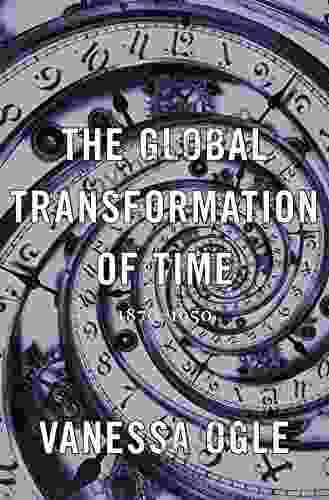The Global Transformation of Time: 1870 - 1950

Time, an enigmatic concept that transcends human experience, has undergone a remarkable transformation throughout history. From the sundials of ancient Egypt to the atomic clocks of the modern era, our methods of measuring and understanding time have evolved significantly. The period between 1870 and 1950 stands as a pivotal era in this evolution, witnessing an unprecedented convergence of technological advancements and societal changes that reshaped our perception and measurement of time.
4.5 out of 5
| Language | : | English |
| File size | : | 1785 KB |
| Text-to-Speech | : | Enabled |
| Screen Reader | : | Supported |
| Enhanced typesetting | : | Enabled |
| Word Wise | : | Enabled |
| Print length | : | 288 pages |
The Industrial Revolution and the Need for Synchronization
The Industrial Revolution, with its emphasis on efficiency and standardization, played a crucial role in driving the transformation of time. As factories and transportation systems expanded globally, the need for a synchronized timekeeping system became paramount. Prior to this era, each town and city maintained its own local time, based on the position of the sun. This decentralized approach led to confusion and inefficiencies in scheduling and transportation.
In response to these challenges, the concept of standard time emerged. In 1884, the International Meridian Conference in Washington, D.C., established a system of 24 time zones, each based on a central meridian. This standardized approach allowed for more efficient communication and coordination across vast distances.
The Role of Railroads and Telegraphs
The development of railroads and telegraphs further accelerated the need for standardized time. Railroads, which enabled rapid long-distance travel, required precise scheduling to avoid accidents and ensure efficient operations. Similarly, the telegraph, a revolutionary communication technology, relied on accurate timekeeping for message transmission and delivery.
The synergy between railroads and telegraphs created a pressing demand for a universal timekeeping system. In the United States, the General Time Convention was established in 1859, introducing four standard time zones. By 1900, most major countries had adopted similar time zone systems.
The Precision of Atomic Clocks
Another significant development in timekeeping during this period was the invention of atomic clocks. In the early 20th century, scientists discovered that the natural vibrations of certain atoms could provide an incredibly precise and stable timekeeping mechanism. Atomic clocks, first developed in the 1940s, revolutionized time measurement with their unprecedented accuracy, exceeding traditional methods such as pendulum clocks and sundials by Free Downloads of magnitude.
The advent of atomic clocks had a profound impact on various scientific fields, including navigation, astronomy, and physics. It also provided a reliable reference for international timekeeping, leading to the establishment of the Coordinated Universal Time (UTC) system in 1960.
Social and Cultural Implications
Beyond its technological advancements, the transformation of time also had profound social and cultural implications. As standardized timekeeping systems became more prevalent, they influenced daily life in numerous ways.
One significant impact was the rise of the "clock culture" in industrialized societies. Prior to the 19th century, work and leisure activities were often dictated by natural rhythms such as daylight and seasonal changes. With the of standard time and factory schedules, time became a more rigid and organized concept, separating work life from personal life.
Standardized time also influenced the perception of punctuality and efficiency. As societies became more interconnected, adhering to schedules and timetables became increasingly important for social and economic interactions. Timeliness emerged as a valued trait, shaping cultural norms and expectations.
Global Connectivity and the Spread of Timekeeping
The globalization process that accelerated in the late 19th and early 20th centuries further contributed to the spread of standardized timekeeping. Imperial powers, seeking to expand their influence and trade, imposed their time zones on their colonies and territories.
As a result, time zones became a symbol of geopolitical power and influence. The British Empire, with its vast global reach, played a pivotal role in disseminating its time system, Greenwich Mean Time (GMT),which became the de facto standard for much of the world.
The period from 1870 to 1950 witnessed a remarkable transformation in the global perception and measurement of time. Technological advancements, societal changes, and the forces of industrialization and globalization converged to reshape our understanding of this fundamental concept.
The establishment of standardized time zones, the invention of atomic clocks, and the spread of timekeeping systems across the globe had profound implications for economic development, social organization, and cultural norms. These changes continue to shape our lives today, as we navigate an increasingly interconnected and time-conscious world.
By exploring the historical context and global impact of timekeeping, we gain a deeper appreciation for the complex relationship between time, technology, and human society.
4.5 out of 5
| Language | : | English |
| File size | : | 1785 KB |
| Text-to-Speech | : | Enabled |
| Screen Reader | : | Supported |
| Enhanced typesetting | : | Enabled |
| Word Wise | : | Enabled |
| Print length | : | 288 pages |
Do you want to contribute by writing guest posts on this blog?
Please contact us and send us a resume of previous articles that you have written.
 Book
Book Novel
Novel Page
Page Chapter
Chapter Text
Text Story
Story Genre
Genre Reader
Reader Library
Library Paperback
Paperback E-book
E-book Magazine
Magazine Newspaper
Newspaper Paragraph
Paragraph Sentence
Sentence Bookmark
Bookmark Shelf
Shelf Glossary
Glossary Bibliography
Bibliography Foreword
Foreword Preface
Preface Synopsis
Synopsis Annotation
Annotation Footnote
Footnote Manuscript
Manuscript Scroll
Scroll Codex
Codex Tome
Tome Bestseller
Bestseller Classics
Classics Library card
Library card Narrative
Narrative Biography
Biography Autobiography
Autobiography Memoir
Memoir Reference
Reference Encyclopedia
Encyclopedia G K Derosa
G K Derosa Harriet Welty Rochefort
Harriet Welty Rochefort Scott Carney
Scott Carney Sylvia Day
Sylvia Day Victoria Waller
Victoria Waller Claire Nance
Claire Nance Jack L Grossman
Jack L Grossman Jonah Winter
Jonah Winter Stuart H Brody
Stuart H Brody Wayne Rohde
Wayne Rohde Black Rose
Black Rose Spencer Wells
Spencer Wells Sonia Wachstein
Sonia Wachstein Michael W Waters
Michael W Waters Scott Hartshorn
Scott Hartshorn Zita Grant
Zita Grant Tyrone Mckinley Freeman
Tyrone Mckinley Freeman Levi Tillemann
Levi Tillemann Bethany Hamilton
Bethany Hamilton William Goldman
William Goldman
Light bulbAdvertise smarter! Our strategic ad space ensures maximum exposure. Reserve your spot today!

 Carl WalkerUnveiling the Enchanting Secrets of Puerto Rico's Eastern Coast and El Yunque...
Carl WalkerUnveiling the Enchanting Secrets of Puerto Rico's Eastern Coast and El Yunque... Javier BellFollow ·17.3k
Javier BellFollow ·17.3k Hugo CoxFollow ·4.7k
Hugo CoxFollow ·4.7k Clark CampbellFollow ·6.7k
Clark CampbellFollow ·6.7k Dalton FosterFollow ·16.9k
Dalton FosterFollow ·16.9k Chase MorrisFollow ·5.4k
Chase MorrisFollow ·5.4k Garrett BellFollow ·4.1k
Garrett BellFollow ·4.1k Harry HayesFollow ·4.9k
Harry HayesFollow ·4.9k Deion SimmonsFollow ·13.6k
Deion SimmonsFollow ·13.6k

 Donald Ward
Donald WardUnveiling the Enthralling World of "Belong to the Baddest...
In the vibrant and...

 José Martí
José MartíCrowned Crows of Thorne Point: A Literary Odyssey into...
In the realm of literary masterpieces,...
4.5 out of 5
| Language | : | English |
| File size | : | 1785 KB |
| Text-to-Speech | : | Enabled |
| Screen Reader | : | Supported |
| Enhanced typesetting | : | Enabled |
| Word Wise | : | Enabled |
| Print length | : | 288 pages |

















